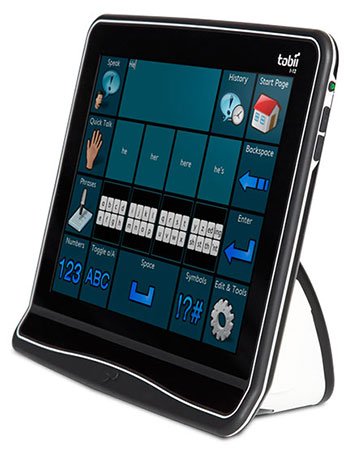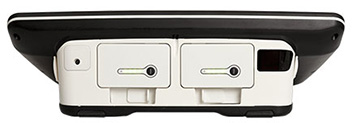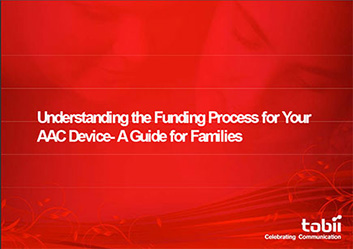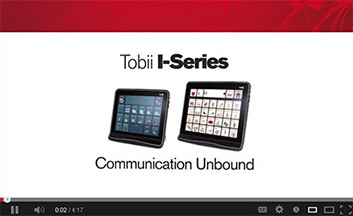Internal mini form
Contact Us Today
![]()
Tobii I-Series Eye Tracking Communication Device Opens World of Communication for Non-Verbal Individuals

Opening up the world of communication for a nonverbal child or adult can be a challenge, but today, technology continues to amaze.
Tobii Technology, which has led the charge for eye tracking and gaze interaction technology for individuals that are nonverbal and with limited ability to physically interact, announced that its new Tobii I-Series is now available. The new generation of speech generating devices offers several improvements based on customer feedback and technological advances that build on the success of its C-Series.
“The I-Series brings about numerous game-changing innovations to the assistive technology market, helping us all re-envision what an assistive device can do for our users,” said Oscar Werner, executive vice president of assistive technology at Tobii. “With the precision of Tobii’s gaze interaction technology, the I‐Series gives not only voice to people who can’t speak but also a sense of control and greater independence. It gives people their lives back.”
The Tobii I-Series was designed as an assistive/augmentative communication device for people who are nonverbal, but also have difficulty controlling other parts of their body. Often, people with Cerebral Palsy, muscular dystrophy, Lou Gehrig’s disease or spinal cord injuries have little or no control of their hands or feet. The Tobii is unique in that it is operated by the eyes – which opens up a new option for people who previously had few.
The device works by using forward- and rearward-facing infrared cameras that are mounted on a screen. The cameras pick up the activity of the cornea, which allows a user to stare at a phrase or a symbol and “activate” it much like a mouse click would activate a computer screen. The user can then spell words, string together phrases, and express ideas that allow them to take part in conversations, build relationships, participate in educational and recreational activities and take part in aspects of life that other people enjoy.
Big changes, new opportunities
The new I-Series features two versions – the I-12 and the I-15. The I-12 has a 12-inch captive touch screen, and the I-15 has a 15-inch screen. The larger screen display is typically a better option for users that require more communication options. Both versions are designed to process acute measurement of eye faster than previous devices – which means users should be able to converse quicker, and for longer periods of time.
Because the Tobii is individually-customized to meet a person’s specific needs, it represents a huge step forward for individuals that are nonverbal.
As researchers and engineers at Tobii began to develop the I-Series, they took into account customer feedback and made some changes they believe users and their caregivers will find attractive, said Tara Rudnicki, the President of Tobii ATI.

“Independence and inclusion is something that should occur 24/7, and we wanted to build a device that enabled users to be more social,” she said. “We also wanted it to be more durable and have more features for the user. So we changed its weight distribution and sound quality so people can enjoy better oral communication. We also developed Wake-On-GazeTM and Sleep-on-GazeTM, which allows the device to sleep. This should make the device easier to use for people who can’t turn it on and off themselves.”
Wake-On-GazeTM and Sleep-On-GazeTM, when paired with the improved battery life in the I-Series also represents a significant development for users. The Tobii I-Series can be used continuously for about nine hours; if it’s sleeping during the time of non-use, the batteries could be used without re-charging for significantly longer periods of time. This improvement is of benefit for those whose batteries frequently run low.
“Efficient use of the gaze options can provide over 24 hours without having to recharge batteries,” she said.

Are you interested in purchasing a Tobii I-12 or Tobii I-15 communication device? Tobii has published a tutorial designed to provide an overview of how augmentative/alternative communication and speech generating devices are funded in the United States. To learn more, visit Tobii Financial Tuturial.
Another big plus for users is that the new I-Series is fully-integrated with no separate parts, which eliminates the prospect of assembly. Also, the new device has a wedge-design that allows users to stand it upright for ease of use without having to mount the device. Or, the device can be laid on a surface for touch interaction – whatever is easier based on a user’s physical needs.
Additionally, the long-term durability of the Tobii was enhanced by the inclusion of a damage-resistant touch screen made of Gorilla GlassTM, which is a first for any assistive device.
Social prospects
The biggest advantage people who are non-verbal can realize by using assistive and augmentative devices is the prospect of engaging in two-way conversation. That’s the basis of forming attachments with family members and friends. It’s also a game-changer in terms of participating at school, or being able to participate in the workplace.
For Tobii users, sometimes it’s the first time such an avenue is available, which is a source of pride for its creators.
“The children that have used our devices are resilient, and it’s one of the best parts of our job,” said Stephan Flloyd, the marketing manager at Tobii.
To meet a user’s social needs, the Tobii I-Series has improved its interactive options. Tobii communicator page allows users to use social media sites like Facebook or Skype with near-pixel precision, and send instant messages and emails with ease. This alone allows a user to communicate easily with someone who is not in a room with them. Additionally, the dual cameras allow users to take photos easily.
Environmental controls have also been modified to manage lights, air conditioning, doors, telephone and televisions, which gives users an increased capacity to act independently.
Availability and affordability
For people who have barriers communicating with others, any assistive device that can help break the barrier is highly-desired because it has the possibility of enhancing a person’s life at a critical, and basic, level.
Ryan Carter, a Tobii user who participated in beta testing for the I-Series, said the new device has given him options in his life that he did not have before.
“Tobii has given me a tool that has changed my life,” he said. “It has given me freedom to say whatever I want to say when I want to say it. I can now make phone calls and text, get on the Internet and look-up what I want to. I can control my TV with it – and that’s a big deal for me! I can communicate quickly and effortlessly now.”
But from a practical standpoint, is the Tobii the right solution for everyone? Is it an affordable option? Those are questions the Tobii team can help a parent or potential user resolve.

Tobii Assistive Technology Inc. is a wholly owned subsidiary of Tobii Technology. For nearly two decades, Tobii ATI has been helping men, women and children with disabilities such as autism, Cerebral Palsy, Lou Gehrig’s disease (ALS), muscular dystrophy, Rett syndrome and spinal cord injury lead fuller, richer lives. Through its commitment to serving its customers – individuals, families, doctors, therapists, schools and rehabilitation centers – Tobii ATI has developed a reputation as an innovative and caring industry leader that continues to push the boundaries of what’s possible to deliver the most advanced, effective and empowering communications tools available for a wide array of disabled communities through award-winning eye tracking and gaze-controlled hardware and software. Tobii is the global leader in eye tracking and gaze interactions.
“We’ve worked with private insurers and with philanthropic organizations to provide resources to people who can help them,” said Rudnicki. “Two big factors that we face are money and the market – supply and demand is important.”
Rudnicki added that if the market for the Tobii increases, more units would be sold which could drive down costs and make it more affordable for others to purchase. Currently, there are about 7,500 Tobiis in use in the United States, but the number of people who could benefit from the technology is likely far greater than the number of devices in circulation.
Tobii does offer a rental program that allows a potential user to use the device for 30 days to see if it’s beneficial to them before making a financial investment. Also, there is a comprehensive funding guide that can help potential buyers determine what resources are available to acquire the product.
Medicare coverage depends on whether Medicare is paying for the device directly or through a Health Maintenance Organization, and what condition an individual has. Medicaid coverage for assistive devices vary widely from state to state, as well.
For more information
For more information about the Tobii I-Series, visit the Tobii website.
For more information on eye tracking technology and solutions, visit Tobii eye tracking communication devices.
To learn about Tobii on YouTube, visit Tobii YouTube.
To learn more about Tobii I-12 and Tobii I-15, visit Tobii eye tracking communication devices.
To learn about Tobii I-Series’ Wake-on-GazeTM and Sleep-on-GazeTM components, mounting versatility, Gorilla GlassTM durability, and battery live, visit Tobii is Ready When You Are.
To learn how users of Tobii I-Series’ can access Facebook, Twitter, blogs and websites, as well as text and email family and friends, visit Get Socially Connected with Tobii.
To contact Tobii for more information, visit Tobii contact information.

Associative conditions
Cerebral Palsy affects muscle tone, gross and fine motor functions, balance, coordination, and posture. These conditions are mainly orthopedic in nature and are considered primary conditions of Cerebral Palsy. There are associative conditions, like seizures and intellectual impairment that are common in individuals with Cerebral Palsy. And, there are co-mitigating factors that co-exist with Cerebral Palsy, but are unrelated to it. Understanding conditions commonly associated with Cerebral Palsy will enhance your ability to manage your child’s unique health concerns.
Associative Conditions
Common associative conditions
Click on a condition listed below to learn more.

Assistive Technology
It’s hard to find an aspect of life that is not touched in some way by technology. For people with disabilities, technological advances offer opportunities for inclusion in every aspect of life – home, school, work, and play. Assistive technology breaks down the barriers that include activity limitations and participation restriction. These advances form the nerve center of the disability movement – equal opportunity.
About Assistive Technology
Communication-Enhancing Technology
- Augmentative and Alternative Communication
- Auditory Devices: Cochlear Implants
- Non-Verbal Communication: Eye-Tracking Technology





